LANDMARKS
On Vikram Samvat 1978 (1922 AD), through some blessings, our ever-so-merciful Pu. Gurudevshree, first laid his hands on Samaysaar. Samaysaar is written by one of the most revered Digamber Jain ascetic, Sh.Kundkundaacharyadev. Due to his inborn spiritual inclination from earlier births, he immediately found great happiness in reading it. He knew that he had found what he was looking for – the eternal truth. It was then he accepted the truths of Jainism preached by the ‘Digamber’ sect. Post realization, he couldn’t continue with the fallacious morals and mannerisms of the other sect. Pu. Gurudevshree was guilt ridden with this internal conflict decided to publicly denounce the false priesthood and became a ‘Sadhak Brahmachari’ i.e. a religious celibate of the Digamber sect. He underwent this auspicious shift on Tuesday at 1:15 pm, Chaitra sud 13,Vikram Samvat 1991 (16-04-1935 AD) (i.e. Mahaveer Jayanti); in the small village of Songadh in a secluded house called the ‘Star of India’. He renounced all the symbols of his previous sect in front of Lord Parshwanath’s photo frame. Regardless of the backlash he faced from the community of the other sect; the devoted, courageous and indifferent Pu. Gurudevshree continued his internal penance with tenacity and unfailing strength. This unwavering strength gave others the courage to follow the same path, leading to salvation. It was nothing less than a revolution! Once the ‘roaring lion’ of the other sect, peacefully settled into the quiet Songadh to pursue his salvation.
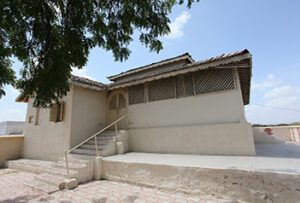

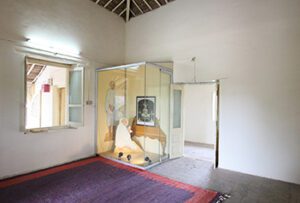

Pu. Gurudevshree would meditate in Star of India, away from the masses, it was so quiet and peaceful that even footsteps could be heard. Thousands of people who used to listen to his discourses before his conversion, left their violent and aggressive thoughts behind, came back to see Pu. Gurudevshree, who was meditating in peace. The devotees, who addressed him as “Prabhu, Prabhu” i.e. Lord Equivalent, believed in his truth. His sermons and answers to the queries posed by these spiritual seekers satisfied them all. They would calmly and humbly bow in front of this sage.This caused an onset of masses in Songadh. Through great insistence from his followers, Pu. Gurudevshree started giving a Pravachan i.e. sermon daily. While walking around in the Star of India Pu. Gurudevshree used to think to himself, “Ahaa! One dravya i.e. Substance doesn’t affect another dravya, who will accept such a fact? Words are not written with this pen (Red coloured pencil), who will understand this? Instead, today thousands of devotees have accepted the independence of Substances from each other. The pure voice preaching self-actualization echoed from Star of India, a small cottage perched on top of a small hill, which could be compared to the sacred grounds of ‘Sammedshikar’! Pu. Gurudevshree lived in this cottage for exactly 3 years, 3 months and 3 days. This historic place is preserved. Star of India is a highly respected place because from here, the almost forgotten Jainism philosophy was revived in Vikram Samvat 1991 (1935 AD).
વીરકથિત સ્વાત્માનુભૂતિનો પંથ પ્રકાશનહારા.
ગુરૂજી જન્મ (ધર્મ) તમારો રે….
જગતને આનંદ દેનારો…..
Reference: Visit Here
Pu. Gurudevshree’s stay in Star of India made it a tirthsthaal i.e. pilgrimage. Spiritual seekers came there from different parts of the world. The sermons became so popular that the space became less to accommodate everybody. For this reason, the followers made a new hall. During discussions about the same, Pu. Gurudevshree said that, ‘since this has been constructed for doing swadhyay i.e. self-study; it should be named ‘Swadhyay Mandir’!’ When the followers requested Pu. Gurudevshree to come to the Swadhyay Mandir, that time this honourable, truth-loving, extremely pure and detached sage said, “If at any moment in time, I get immersed in attaining Vairagya (walking on the path of attaining ultimate inner peace by letting go of all worldly and bodily emotions) I will venture out into the jungle. At that time, I will not be able to take care of this Swadhyay Mandir like the monks of other religions take care of their temples. Post this statement, the followers, with tearful eyes and extreme sincerity, implored him by saying, “Oh Pu. Gurudevshree, stay here until whenever you please, but please fulfil this wish of ours.” Their wishes were fulfilled.
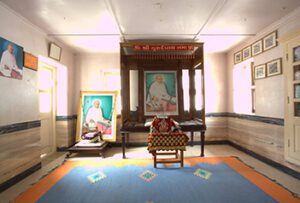

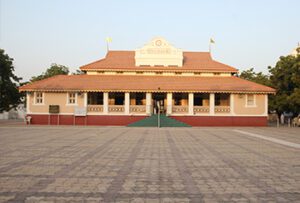

This was Songadh’s first auspicious occasion. By the orders of Pu. Gurudevshree, within a niche in the wall of the Swadhyay Mandir, Shree Pargaman Samaysaarji was decided to be placed by none other than Pu. Bahenshree Champaben’s holy hands. The 25 feet x 50 feet swadhyay mandir looked as if it was a floating streamer! The disciples had decorated its interiors. Such that the Swadhyay hall looked like a garden. All the sides of the wall had ‘sutras’ or verses written on it. A few days before the opening of the Swadhyay Mandir, the followers went for prabhat pheris (i.e. processions) with little flags in their hands to show their devotion and bhakti. “સુરેન્દ્રો ઉતરો ગગનના આજ સુવર્ણના સ્વાધ્યાય મંદિરમાં.” “Surendro utaro gaganna aaj suvarnana swadhyay mandir ma” which means celestial beings in the sky please descend and come to Songadh’s Swadhyay Mandir. On the auspicious day of Vaishakh Vad 8, Vikram Sawant 1994 (1938 A.D.) all the followers went to Star of India and got Pu. Gurudevshree. Midway, all the women placed Shree Samaysaarji on a silver plate on Pu. Bahenshree’s hands and joined the procession coming for Star of India. Shree Samaysaarji’s holy placement was done in accordance to the Pratishtha Vidhi i.e. rites and rituals by Bramhachari Sheetal Prasadji. During the sermon, Pu. Gurudevshree narrated the inexplicable greatness of Shree Samaysaarji. Additionally, he also explained the seriousness and intensity of the scripture. He said how much, in his heart, he revered the great ascetic Kundkundaacharya and how these emotions were stirring up while explaining the essence of Samaysaarji. It was clearly visible that Pu. Gurudevshree recalled memories of his previous birth with Pu. Kundkundaacharya. It was during these days, Pu. Gurudevshree gave the title of veneration, “Bhagvati”, to Pu. Bahenshree Champaben.
ધર્મધ્વજ ફરકે છે મારે મંદિરિયે,
સ્વાધ્યાય મંદિર સ્થપાયાં અમ આંગણીયે
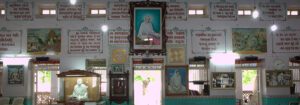

Reference: Visit Here
Gujarati story book of paintings in this landmark: Download Here
Hindi story book of paintings in this landmark: Download Here
In 1939 A.D. (Vikram Samvat 1995) Pu. Gurudevshree went on a pilgrimage to Shatrunjay Siddhidham (place from where many souls attained moksha i.e. liberation from life and death cycle). Our revered Pu. Gurudevshree Kanjiswami and Pu. Bahenshree Champaben felt that “We are already devoid of the real God’s presence, on top of which we are also devoid of the sight of the Vitragi i.e. neutral towards emotions and peaceful God’s idol!” At that moment, Sh. Nanalal Jasani, a man of generous nature and immense devotion to Vitragi Dev and Guru, suggested that a Jain temple be constructed in Songadh, Gujarat and Pu. Gurudevshree gave his consent to it.
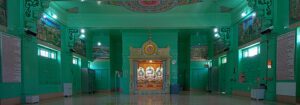

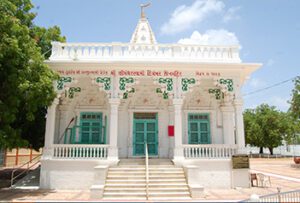

The creation of the Jain temple soon began. Pu. Gurudevshree read the Vasunandi Pratishtha Paath himself. He advised Pu. Bahenshreeben to go to Jaipur and bring the statues. He gave every kind of suitable advice and Pu. Bahenshree Champaben’s past life memories (Jatismarangyan – Vikram Samvat 1993 (1937 A.D.)) of Videhkshetra’s Simandhar Bhagwan was instrumental in God’s idol selection process.
In one sculptor’s shop, three idols of God were present together (in the same manner the three idols of God are present in the Songadh temple even today); on seeing that, Pu. Bahenshree was delighted. Seeing the Vitrag, tranquil and peaceful expressions that radiated from the idol, she told the sculptor, “I want to take these very pure Digamber Jain idols.” She brought the idols along with her in the train on the way back to Songadh.
One morning Pu. Gurudevshree had a dream that three lights are approaching him. He told the mumukshus, “Go to the station and welcome them! Three Gods are arriving!” Pu. Bahenshree was astonished as she descended the train! The disciples told her, “We have come as per the orders of Pu. Gurudevshree.” Songadh’s disciples were heartfelt and chanted that ‘God has descended, God has descended’ during the procession, as their wish of sight of God came true. As the box containing the God’s idols were opened, Pu. Gurudevshree instantly uttered the words, “Aahaha! God has enlightened us!” He was overwhelmed with feelings of devotion, and tears of happiness started rolling down his cheeks.
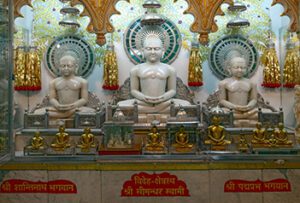

The preparations for the Panchakalyanak Pratishtha (a holy ritual, usually 5 days long, followed by which the God’s idol is placed in the temple) were still on, when Pu. Gurudevshree would often sit next to the idol and sing…
“અમીયભરી મૂર્તિ રચી રે, ઉપમા ન ઘટે કોય
શાંત સુધારસ ઝીલતી રે, નિરખત તૃપ્તિ ન હોય..
સીમંધરજિન દિઠા લોયણ આજ….”
Pu. Gurudevshree would show the idol to every visitor who came to Songadh and exclaim, “Come! Shall I show you my God? Did you see? Did you see my God?”. He would show everyone the idol with such immense happiness and delight. He himself would often gaze and observe the idol, as if he were seeing a real God in front of his eyes! Pu. Gurudevshree would observe the idol with tearful eyes and say, “O Lord! We will forget the pain of your physical absence by placing your idol before us.”
The religious Panchakalyanak Pratishtha celebrations were for 8 days from Mahaa Vad 11 to Faagan Sud 2, Vikram Samvat 1997 (1941 A.D.). The devotees were overjoyed, as if Panchakalyanak of God personified were being celebrated! While the Pratishtha was being celebrated, Pu. Gurudevshree’s discourses were brimming with the joy of having met the Lord himself.
The first Pratishtha ever! The devotees were extremely delighted to meet God (idol) himself. This was a lifetime experience and they were ecstatic. One could see sights of devotees filled with powerful and joyous emotions. How can one describe the devotee’s joy when Simandhar Bhagwan entered the temple? In the temple, three big marble idols of Lord Simandhar, Lord Shantinath and Lord Padmaprabhu are present. Below, the metal idols of Lord Adinath, Lord Neminath and Lord Mahavir and the crystal idol of Lord Parshwanath are present. The temple is beautifully decorated with the Simhaasan, Bhamandal, Chaamar, and Chhatra (i.e. Silver throne, Halo, Decorative fan and 3 Auspices respectively).
The number of devotees visiting Songadh were increasing. After a few years, in Vikram Samvat 2013 (1957 A.D.), the devotees renovated the temple once again. In honour of Pu. Gurudevshree being 68 years old at that time, the temple was constructed to be a height of 68 feet. To the North of the Lords idol, there are pictures of Lord Shantinath previous life, Pu. Gurudevshree’s pilgrimage to Sammedshikhar, Lord Mahavir, 7 monks and Lord Naminath. To the East of the Lords idol, there are pictures of Lord Adinath previous life, Jambuswami, Devki’s sons at her house, and Aahardaan (method of offering food to Digamber monks) to ascetics. To the South of the Lords idol, pictures of some Jaintemples inspired by Pu. Gurudevshree; Lord Ram with Deshbhushan and Kulbhushanmonks; Lord Simandhar Diksha Kalyanak (renunciation ceremony); Pu. Gurudevshree reading some Holy Scriptures; and Pu. Gurudevshree’s boat ride in Siddhvar Kut, are present. The main door of the temple has an inscription of ‘Om’ on it. An idol of Lord Neminath is present on the second level of the temple. It is very beautiful. One can also see the Lord in the upper echelon of the Manasthambh, the peak of Shatrunjaya and the entire Songadh temple complex from upstairs.
સાતિશય જિનવર મંદિર હૈ, દિવ્યમૂરતિ સીમંધર જિનકી,
જિનકે દર્શનકર જગ પ્રાણી, આતમ શાંતિ સુખ પાતે હૈં.
The pious influence of our liberator Pu. Gurudevshree Kanjiswami was growing by leaps and bounds. The size of Pu. Gurudevshree’s devotees kept on expanding. The Swadhyay mandir was too small to accommodate large number of people during the time of festivals. Thus, it was decided to construct a bigger hall for sermons. A rich merchant from the town of Indore, Sir Seth Hukamchandji happened to arrive at Songadh in the year Vikram Samvat 2001 (1945 A.D.). He performed the ceremony of Shilanyas (laying the foundation stone) for the Pravachan Mandap. He was deeply influenced by the spiritual aura of this place. Hence, on Faagan Sud 1, Vikram Samvat 2003 (1947 A.D.) even the inauguration of Pravachan Mandap was done by him.
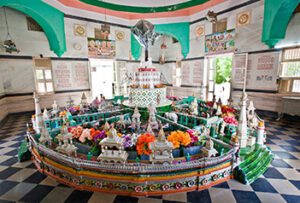

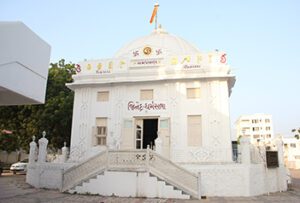

In this architectural marvel of a pillarless room of 50 feet x 100 feet Pu. Gurudevshree would give discourses. The hall would be packed with keen listeners enjoying the pure and sweet tone of his voice. Beautiful ancient pictures are carved on the walls of Pravachan Mandap. For many years during the time of festivals Pu. Gurudevshree would come here for pravachan sessions. When it was decided to make a memorial for Pu. Gurudevshree, Pu. Bahenshree and the entire trustee group decided to adorn the Pravachan Mandap with 144 pictures which threw light on Pu. Gurudevshree’ ideal life. While entering from the north direction one would find a large picture measuring 4 x 6 feet which portrays an image of Pu. Gurudevshree bowing down to Lord Kundkundaacharya. Shree Amrutchandraacharya and Padmaprabhmaldharidev are there on the back. In the west there is a grand portrait of Pu. Gurudevshree with a prayer dedicated to him. Pu. Gurudevshree’s place of birth Umrala, the handwritten letter at the time of deeksha i.e. renunciation, the deeksha period, the transformation in Star of India, twelve pictures describing Pu. Gurudevshree’s life,the inauguration of Swadhyay Mandir, Pu. Bahenshree moving in the procession with Samaysaarji in her hands, Sir Seth Hukamchandji, Sir Pattani, Bhapsinhji Darbar (King of Bhavnagar at that time), the glorious temples of Songadh, various elegant poses of Pu. Gurudevshree, the religious tours, autographs, letters of commendation and many other special occasions are portrayed here. Large picture frames kept on the huge tables are enchanting.
The Pravachan Mandap is transformed in a museum where Pu. Gurudevshree’s autograph, his daily routine, the temples sanctified by him and many more articles are displayed. This “Kahan Guru Prabhavna Darshan” photo gallery is alluring the history of Pu. Gurudevshree and has been displayed beautifully by the heartfelt contribution of Pu. Bahenshree to her spiritual mentor. Also, the translated hymns (in Gujarati) of the five Parmagamas i.e. Kundkundaacharya’s 5 holy scriptures; penned by Pandit Himmatbhai Shah are carved on the marble walls of the Mandap as a tribute to Sh. Kundkundaacharaya. This “Kahan Guru Prabhavna Darshan” was inaugurated on Chaitra Vad 13, Vikram Samvat 2045 (1990 A.D.).
>પ્રવચન મંડપ સુવિશાલ અહા, ગુરૂ પ્રભાવનાકા સ્મારક હૈ,પૌરાણિક ચિત્રાવલિ અંકિત, પંચપરમાગમ હરિગીત રચે.
The pious influence of our liberator Pu. Gurudevshree Kanjiswami was growing by leaps and bounds. The size of Pu. Gurudevshree’s devotees kept on expanding. The Swadhyay mandir was too small to accommodate large number of people during the time of festivals. Thus, it was decided to construct a bigger hall for sermons. A rich merchant from the town of Indore, Sir Seth Hukamchandji happened to arrive at Songadh in the year Vikram Samvat 2001 (1945 A.D.). He performed the ceremony of Shilanyas (laying the foundation stone) for the Pravachan Mandap. He was deeply influenced by the spiritual aura of this place. Hence, on Faagan Sud 1, Vikram Samvat 2003 (1947 A.D.) even the inauguration of Pravachan Mandap was done by him.
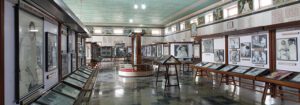



In this architectural marvel of a pillarless room of 50 feet x 100 feet Pu. Gurudevshree would give discourses. The hall would be packed with keen listeners enjoying the pure and sweet tone of his voice. Beautiful ancient pictures are carved on the walls of Pravachan Mandap. For many years during the time of festivals Pu. Gurudevshree would come here for pravachan sessions. When it was decided to make a memorial for Pu. Gurudevshree, Pu. Bahenshree and the entire trustee group decided to adorn the Pravachan Mandap with 144 pictures which threw light on Pu. Gurudevshree’ ideal life. While entering from the north direction one would find a large picture measuring 4 x 6 feet which portrays an image of Pu. Gurudevshree bowing down to Lord Kundkundaacharya. Shree Amrutchandraacharya and Padmaprabhmaldharidev are there on the back. In the west there is a grand portrait of Pu. Gurudevshree with a prayer dedicated to him. Pu. Gurudevshree’s place of birth Umrala, the handwritten letter at the time of deeksha i.e. renunciation, the deeksha period, the transformation in Star of India, twelve pictures describing Pu. Gurudevshree’s life,the inauguration of Swadhyay Mandir, Pu. Bahenshree moving in the procession with Samaysaarji in her hands, Sir Seth Hukamchandji, Sir Pattani, Bhapsinhji Darbar (King of Bhavnagar at that time), the glorious temples of Songadh, various elegant poses of Pu. Gurudevshree, the religious tours, autographs, letters of commendation and many other special occasions are portrayed here. Large picture frames kept on the huge tables are enchanting.
The Pravachan Mandap is transformed in a museum where Pu. Gurudevshree’s autograph, his daily routine, the temples sanctified by him and many more articles are displayed. This “Kahan Guru Prabhavna Darshan” photo gallery is alluring the history of Pu. Gurudevshree and has been displayed beautifully by the heartfelt contribution of Pu. Bahenshree to her spiritual mentor. Also, the translated hymns (in Gujarati) of the five Parmagamas i.e. Kundkundaacharya’s 5 holy scriptures; penned by Pandit Himmatbhai Shah are carved on the marble walls of the Mandap as a tribute to Sh. Kundkundaacharaya. This “Kahan Guru Prabhavna Darshan” was inaugurated on Chaitra Vad 13, Vikram Samvat 2045 (1990 A.D.).
પ્રવચન મંડપ સુવિશાલ અહા, ગુરૂ પ્રભાવનાકા સ્મારક હૈ,
પૌરાણિક ચિત્રાવલિ અંકિત, પંચપરમાગમ હરિગીત રચે.
Reference: Visit Here
Gujarati story book of paintings in this landmark: Download Here and Download Here
Hindi story book of paintings in this landmark: Download Here and Download Here
After the conversion of the benevolent and spiritual soul – Pu. Gurudevshree Kanjiswami to Digamber Jain, in Vikram Samvat 1991 (1935 A.D.) there had been an exponential increase in the religious activities at Songadh. The new chapter in the story of the Suvrnapuri – Songadh was “Manastambh” i.e. The Pillar of the Lord’s Glory, the first of its kind to be built in Saurashtra,Gujarat. At that time Pu. Gurudevshree’s age was 63 years leading to the height of the Manastambh being 63ft.
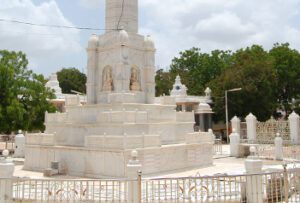

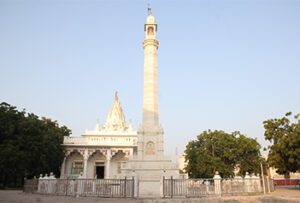

On the auspicious day of Mahaveer Jayanti, Chaitra Sud 13, Vikram Samvat 2008 (1952 A.D.), with the blessed hands of Pu. Bahenshree’s the foundations for the construction of Manastambh were laid down. In the kind and compassionate presence of Pu. Gurudevshree, the event was successful with a lot of grandeur and the enthusiasm from people nationally and internationally. Within a few days itself 8 idols (4 up and 4 down), that were to be placed in the Manastambh, arrived with great pomp. Pu. Bahenshree Champaben inaugurated the depiction of “Samavsharan” with Aacharya Kundkunddev in videhkshetra in the form of a carving at its base.
Pu. Gurudevshree said that the Manastambh in Songadh wasn’t a “keertistambh” i.e. Pillar for fame, but a replica of the 4 Pillars present at the 4 gates of the ‘Samavsharan’ of Jinendra. This Pillar is called “Manastambh” because looking at this pillar leads to humbleness in one and all. As they say – ‘maani’ i.e. an egoist swallows his ‘maan’ i.e. false pride, so also it is after the glimpse of Manastambh. Additionally, Pu. Gurudevshree would call it a beacon of the Lord and his true preaching’s, inviting people from far away to gain from the knowledge offered by the Jinendra.
As the trucks full of materials rolled in, and the Manastambh started coming together, people couldn’t contain their excitement. In Vikram Samvat 2009 (1953 A.D.) came the joyous event of its Prathishta. The grandeur of the event left everyone spellbound and speechless. With emotions running high, people couldn’t contain their devotion towards the Jinendra. Lord Neminath was the ‘Vidhinayak’. Under the solemn guidance of Pu. Gurudevshree, the entire “Panchkalyanak Pratishtha” was conducted with grace. Pu. Bahenshreeben got the opportunity to do ‘Aahardaan’ to Muniraaj Sh. Neminath.
During this majestic event, over 5000 mumukshus came from lands far away to celebrate and rejoice the day marking the presence of the Lord in Songadh. To accommodate these guests, ‘Kahan-Nagar’ was specially constructed. A splendid and grandiose tent was erected for all the rites and rituals. The ambience of entire Songadh was so pure and serene with the euphonious tunes of Bhakti i.e. hymns and prayers, conducted by Pu. Gurudevshree and Pu. Bahenshreeben on a regular basis! It was indeed an ethereal affair! At that stage, it seemed as if we all had reached the ‘Samavsharan’ with Pu. Gurudevshree and Pu. Bahenshree. On the last day of Pratishtha, the devotees were singing hymns in the background and 8 idols of Sh. Simandharswami was placed in the majestic Manastambhon Chaitra Sud 10, Vikram Samvat 2009 (1953 A.D.).
સુવર્ણપુરે સ્વાધ્યાયસુમંદિર, જિનગૃહ ગુરૂજી લાવ્યા..
સમવસરણ, પ્રવચનમંડપ, જિનધર્મવિભવ લહરાયા..
Reference: Visit Here
Pu. Gurudevshree’s popularity was increasing day by day due to his discourses and many pilgrimages. A lot of new Jain temples were made with pious Panchakalyanak Pratishthas. Millions of people were influenced by his mesmerizing persona. A huge number of extremely lucky people from India and abroad had gathered for Pu. Gurudevshree’s 80th birthday celebrations in Mumbai city. The devotees had a divine wish of building an incredibly gorgeous Jin temple in Songadh and a Shilaniyaas ceremony was conducted.
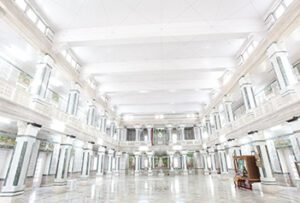

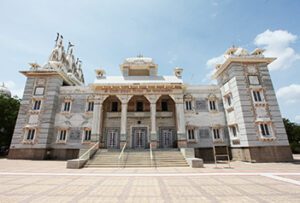

When Pu. Gurudevshree was still in the other sect, he would often have dreams of marble slabs, with the words of ‘Jinvaani’ (Holy Scriptures) inscribed on them, falling from the sky. This dream came true! The words of the five Parmagam Jinvaanis like Samaysaar were inscribed on marble and 0.4 million (4 lakhs) words were successfully inscribed on the walls.
A team visited different Jain and non-Jain temples in all locations for creation of Parmagam Mandir. The team meticulously did all the calculations with utmost precision and devotion to check how many marble slabs will fit in this room, how many ‘gathas’ i.e. verses will fit in each slab, how many words will have to be written so that all the scriptures would fit on the wall. They did the entire calculation to ensure that the writings were inscribed properly in the temple. The trust ordered a machine from Italy and all the inscriptions on the marble slabs were done in Songadh itself. ‘Om’ was the first word to be inscribed on the first slab. Pu. Gurudevshree, whose heart overflows with devotion towards Jinvaani, would often go to see how the work of that was progressing. Whenever it was the beginning of inscribing a new ‘adhikar’, the environment would highly festive.
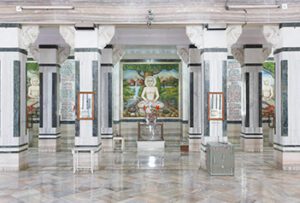

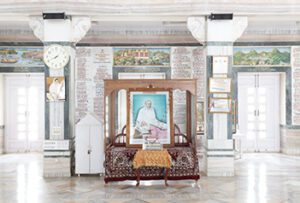

Kundkundaacharya’s primary disciple Pu. Gurudevshree, had witnessed the meeting of Lord Simandhar and Kundkundaacharya in Videhkshetra. Thus, the sacred text on the walls of the temple would make him and Pu. Bahenshree extremely happy. Pu. Bahenshree, with utmost generosity, offered all her money for the inscription of the jinvaanis!
Pu. Gurudevshree would get all the sacred proceedings done by Pu. Bahenshree. With the ultimate happiness of all the devotees present, the entire premise would be filled with excitement and devotion. The walls of the temple have been extolled with the words of the entire Samaysaar, Pravachansar, Niyamsaar, Panchastikay and Ashtapahud. In between the scriptures, pictures of ancient events have been painted. The life story and incarnations of Lord Mahaveer, the past incarnations of Lord Neminath and Lord Adinath have been inscribed. Along with that, pictures of the sacred events of all the tirths and tirthankars, Videhakshetra’s 20 tirthankars, and Acharyas have also been inscribed. Below, the impression of Kundkundaacharya’s feet has been placed. God’s Om Dhvani (God’s words) has also been established.
A masterpiece was created with efforts from the entire team and with pious blessings of Pu. Gurudevshree and Pu. Bahenshree. The celebration of Pratishtha was also memorable and it took place on Falgun Sud 13, Vikram Samvat 2030, Veer Samvat 2500 (1974 A.D.). This temple was a tribute that Pu. Gurudevshree paid to Lord Mahaveer on his 2500th Salvation anniversary year. A majestic invite (patrika) was prepared. This event also manifested into a great celebration.
કેશર કુમ-કુમ રે, રત્નો વર્ષે સુવર્ણપુરી મોઝાર,
આવ્યા આવ્યારે, પ્રતિષ્ઠા મહોત્સવ સુવર્ણપુરીને દ્વાર..
The invites were sent everywhere and over 25,000 devotees came from all over the world came to Songadh. Pu. Gurudevshree’s sermons were also special like the roar of the lion and the devotees of India were enriched. The Pratishtha ended beautifully with salutes to Lord Mahaveer’s laghunandan i.e. youngerson – Pu. Gurudevshree.
પરમાગમમંદિર અદ્–ભૂત હૈ, પ્રભુ મહાવીરકી મૂરતિ હૈ,
કુંદકુંદ ચરણ અભિરામ બને, પંચ પરમાગમ શ્રુત મંદિરમેં.
Reference: Visit Here
Gujarati story book of paintings in this landmark: Download Here
Hindi story book of paintings in this landmark: Download Here
In Songadh, Pu. Gurudevshree’s land of spiritual penance, along with many religious activities Pu. Bahenshree had an evening session with the women every day. Many auspicious and highly valuable maxims given by her were gathered by her devotees in the holy book called ‘Pu. Bahenshree na Vachnamrut’ and published in the year Vikram Samvat 2033 (1977 A.D.) in the presence of Pu. Gurudevshree. Pu. Gurudevshree was highly impressed by the mesmerizing and deep verses of the book written in very simple language. He read the book with different perspectives and expressing his delight; he told the head of the trust Sh. Ramjibhai Doshi that this book is so lucid that 0.1 million (one lakh) copies of it should be printed.


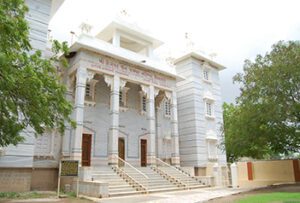

Seeing at Pu. Gurudevshree’s fondness for the book, devotees requested to engrave it on the marble walls. Pu. Gurudevshree accepted to the request happily. Pu. Gurudevshree was not satisfied with the idea of carving it on the walls of the Brahmacharya Ashram for women so he expressed his opinion of constructing a whole new structure for it. Sh. Ramjibhai Doshi decided to put this idea into action. It was decided to build ‘Pu. Bahenshree Champaben Vachnamrut Bhavan’.
The Shilaniyaas ceremony (laying the foundation stone) of this building was done according to the Gujarati calendar on Kartak Sud 5, Vikram Samvat 2037, (1980 A.D.). During the ceremony, Pu. Gurudevshree drew Swastikas on many bricks of the temple.
Thereafter, it was decided to also inscribe Pu. Gurudevshree’s Vachnamrut on the walls and to put deities of Panchmeru (The naturally occurring mountains at the centre of the first 2.5 islands) and Nandishwar Jinalay (The naturally occurring temples in the 8th island in the Middle Earth). The Shilaniyaas ceremony of the ‘Panchmeru Nandishwar Jinalay’ was done in the presence of Pu. Bahenshree.
This temple looks magnificent and is known by three names – ‘Shree Panchmeru Nandishwar Jinalay’, ‘Pu. Gurudevshree Kanjiswami Vachnamrut Bhavan’ and ‘Pu. Bahenshree Champaben Vachnamrut Bhavan’. On the top level there are deities made from pink marble of Lord Adinath first of the present 24 Tirthankaras, the future Tirthankaras of Ghatki Videhakshetra and Jambu Bharatkshetra (other islands). At the bottom level, in Nandishwar there are 52 deities and at its centre, in the Panchmeru there are 80 deities. Pu. Gurudevshree’s Vachnamrut is carved on the marble wall of the ground floor and Pu. Bahenshree’s Vachnamrut on the top floor.
Beautiful portraits of Lord Adinath’s last ten incarnations, Pu. Gurudevshree’s nine incarnations, ‘Om’ and the ‘Swastikas’ are carved in marble walls on the top floor. While on the ground floor, portraits of Pu. Gurudevshree’s whole life, Lord Mallinath’s incarnation, last ten incarnations of Lord Mahaveer and Dharsenacharya’s teaching of Shatkhandagam are carved. At the centre, there is a huge picture of Pu. Gurudevshree measuring (8×8) feet and his life story is written below. All the auspicious eight mangal dravya (i.e. holy ingredients) are engraved on the gate. Elephants and celestial beings coming for prayers are drawn on the roof. Every mountain temple is adorned with Golden painting. As soon as one enters this huge temple, they can experience eternal peace and does not wish to leave this place. The devotees regularly perform prayers, Pooja and bhakti (the holy songs) in this temple. Panchmeru Nandishwar temple has been created according to the description in the holy scriptures, based on Pu. Bahenshree’s Jaatismaran gyan (knowledge about the past lives) and the study of Triloksaar.
Aah! Just like the temple itself the Pratishtha celebrations were majestic. These celebrations took place from Faagan Vad 1 to 7, Vikram Samvat 2041 (1985 A.D.). At the time of the Shilanyas ceremony Pu. Gurudevshree was 91 years old and hence the height of the temple is 91 feet.
The past Panchkalyanak celebrations which took place in the presence of Pu. Gurudevshree were splendid. But, this was the first Panchkalyanak celebrated in his sore absence and it also went well due to his pious influence. Pu. Bahenshree personally gave all the instructions to the Pratishthaacharya (holy ceremony executor) to ensure that the whole event was carried out according to the sacred rituals and traditions. All the event preparations were done in accordance to Pu. Bahenshree’s instructions. The clothes of vidhinayak god, Lord Adinath’s prayer, Nandwidhan, Dhwajkalash, the sixteen dreams, chariot procession, various performances each and everything was done according to Pu. Bahenshree’s virtuous guidance. Due to the virtuous influence of Pu. Gurudevshree and the contribution of Pu. Bahenshree this auspicious occasion went very well.
પંચમેરૂ નંદીશ્વરધામ બના, ભાવિજિનવરજી વિરાજિત હૈ,
આદિનાથ પ્રભુ અરૂ જિનવરવૃંદ, રત્નજડિત વચનામૃત હૈ.
Reference: Visit Here
Gujarati story book of paintings in this landmark: Download Here
Hindi story book of paintings in this landmark: Download Here
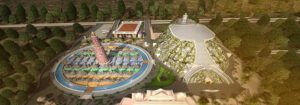

Revered saint Pu. Sadgurudevshree Kanjiswami lived & preached Digamber Jin religion for 45 years in Songadh. Hence, Songadh has become an important pilgrimage location of Jain community around the Globe. Shree Digamber Jain Swadhyay Mandir Trust, Songadh & Shree Kundkund-Kahan Parmarthik Trust, Mumbai are dedicated to dissemination of upsurge of this true Jin’s knowledge by Pu. Gurudevshree and Pu. Bahenshree.
Songadh, Bhavnagar, Gujarat is situated in Bharatkshetra of Jambudweep. Jambudweep is the Centremost Island in island – sea geography of center earth (Madhyalok). Jambudweep also is the home Sudarshanmeru peak. It is the tallest peak in the entire center earth. It houses 16 natural temples (Akratrim Jinalay). There are 62 other natural temples in entire Jambudweep. Each of this natural temple has 108 natural idols. These idols are very beautiful and just like god in his religious court (Samavsaran). It is an exquisite arrangement…
On other hand, Sh. Bahubali Munindra Bhagwan is an exquisite symbol of immovable selflessness and omniscience and is very dear to all the Jains. Thus, Sh. Bahubali Munindra Bhagwan is a symbolic deity of Digamber Jains. Shravanbelagola (near Banglore) is one of the most important holy locations as it houses 57 feet tall 1200 years’ old idol of Sh. Bahubali Munindra Bhagwan.
We (Mumukshus) had envisioned to bring all the above mentioned pious landmarks together as a tribute to Pu. Gurudevshree’s 91 years of sacred life. Therefore, we have an artificial 91 feet tall Sudarshanmeru peak surrounded by Jambudweep’s geography with natural temples and created an artificial hill of 50 feet and have erected a 41 feet, 230 Tonne Sh. Bahubali Munindra Bhagwan’s idol on the top of the hill.
The 41 feet tall statue of weighing 230 Tonnes is one of the world’s tallest statues of Sh. Bahubali Munidra Bhagwan. This statue was made in Bangalore. It is sculpted out of a single block of 400-tonne granite, from Koira near Devanahalli, by renowned artist. The statue has a height of 41 feet, width of 14 feet and thickness of 6.5 feet. It took them 14 months to complete the statue. The search for the right stone and sculptor began two years ago. After an exhaustive search, it was decided that the stone and the sculptor have to be from Karnataka only, as similar stone and style of sculpture akin to the highest, revered and world famous Shravanbelagola Bahubali Munindra Bhagwan in Hassan district.
The foundation laying ceremony (Bhoomi Shilanyas) of Jambudweep and Shree Bahubali Munindra Bhagwan was performed on Vaisakh Sud 3, Vikram Samvat 2069 (13-5-2013 A.D.). Now, we are eagerly waiting for the temple completion and Panchkalyanak Pratishthha Mahotsav. We will be privileged to participate in the Panchkalyanak Pratishthha Mahotsav and know for sure that Pu. Gurudevshree and Pu. Bahenshree will be showering their blessings from their heavenly abode…
Shri Gogidevi Digamber Jain Shravika Bramhacharyaashram was inaugurated on Mahaa Sud 5 (Vasant Panchami), Vikram Samvat 2008 (31-01-1952) by Ladanu resident Sheth Sh. Vachharajji Gangawal. This aashram was constructed for bramhacharibens who decided to devote their lives to learn the principles preached by Pu. Gurudevshree Kanjiswami. The bramhacharibens lived under the pious care of Pu. Bahenshreeben. They regularly received valuable life sermons from Pu. Bahenshree in a swadhyay hall specially constructed for Ladies mumukshus. The name of this hall is Shree Manphoola Digamber Jain Swadhyay Bhavan.
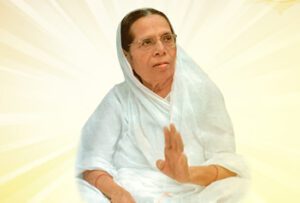

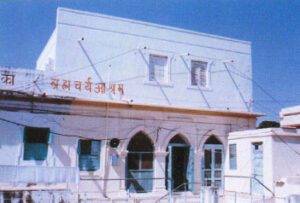

64 well educated and learned bramhacharibens lived here with Pu. Bahenshree Champaben. They did their tatvagyan studies here. The famous book of Pu. Bahenshree’s Vachanamrut was compiled here by these dedicated bramhacharibens. Pu. Gurudevshree recommended Sh. Ramjibhai Doshi, Pramukh of then Sh. Digamber Jain Swadhyay Mandir Trust to publish 1 Lac copies of this valuable treasure. Thus, Shri Gogidevi Digamber Jain Shravika Bramhacharyaashram has become a pilgrimage place due to atmasadhana of revered souls like Pu. Bahenshree Champaben.
Reference: Visit Here
Pu. Gurudevshree Kanjiswami’s Samadhi temple was completed in Vikram Samvat 2037 (1980 A.D.). This temple is constructed on Pu. Gurudevshree’s Samadhi at Songadh. It is made up of marble with a glorious lotus placed in the center of the samadhi. The walls are ornated with carvings depicting the pious past, present and future life of Pu. Gurudevshree. This temple is a humble tribute to our religious father for leading, propagating and preaching the true liberation path as depicted by Lord Mahaveer and one of his most remembered prime disciples of Aacharya Shree Kundkund.
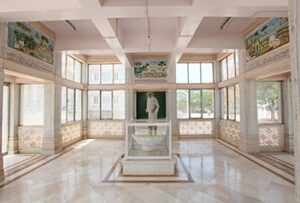

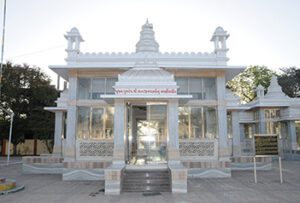

Pu. Gurudevshree was born far away from the truth. He always had a yearning to know and experience the truth about self identity. Single handedly with sheer perseverance he achieved the truth, promoted and propagated the true Digamber Jain religion. The state of the religion was awful prior to Pu. Gurudevshree’s arise. The true philosophy was almost lost among the mundane rituals that people followed blindly. Pu. Gurudevshree studied, experienced and preached the true philosophical side of the religion. He achieved this feat single handedly, thus showing the uniqueness of his soul. Pu. Gurudevshee’s Samadhi temple is a very humble effort to commemorate his benevolence.
Reference: Visit Here
Pu. Bahenshree Champaben’s Samadhi temple was completed in Vikram Samvat 2046 (1990 A.D.). This temple is constructed on Pu. Bahenshree’s Samadhi at Songadh. It is made up of marble with a glorious lotus placed in the center of the samadhi. The walls are ornated with carvings depicting the pious past, present and future life of Pu. Gurudevshree and Pu. Bahenshree. This temple is a humble tribute to our religious mother for leading, propagating and preaching the true liberation path as depicted by Lord Mahaveer, one of his most remembered prime disciples Aacharya Shree Kundkund and Pu. Gurudevshree.
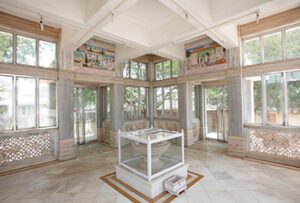



Pu. Bahenshree was born far away from the truth. She always had a yearning to know and experience the truth about self identity. Through her sheer perseverance she achieved the truth and preached it after Pu. Gurudevshree. She was also blessed with Jatismarangyan that revealed Pu. Gurudevshree’s past, present and future. It was Pu. Bahenshree who revealed that Pu. Gurudevshree is going to become world revered Teerthankar Bhagwan in future births. One cannot fail to remember her benefaction and Pu. Bahenshree’s Samadhi temple is a very humble effort to commemorate her benevolence.
Reference: Visit Here
An educational institution was started in presence of Pu. Gurudevshree at Songadh to instill true and best of Jain culture in children to propagate rich traditions of lords (Teerthankars). The institute was named after revered Sh. Kundkundaacharyadev and Pu. Gurudevshree as Sh. Kundkund-Kahan Digamber Jain Vidyarthi Gruh. It started on 27-8-1957 (Bhadarvo Sud 3, V. S. 2013) in Songadh where along with worldly education, religious education was also imparted.
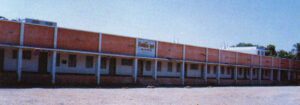

Shri Kanjiswami Digamber Jain Vishrati Grah was constructed by Sh. Digamber Jain Mumukshu Mandal Trust, Mumbai in memory of 85th birthday celebration (Janma Jayanti) of Pu. Gurudevshree Kanjiswami. This facility was built to provide accommodation for aspirant Mumukshus who visits Songadh to study the principles of Jain religion.
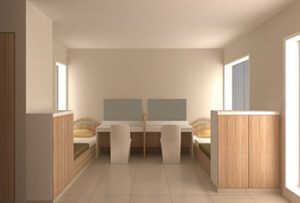

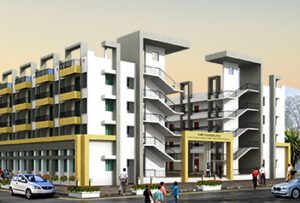

On 16-6-2010 (Jeth Sud 5, V. S. 2066), under the aegis of Shri Anantrai A. Sheth of Mumbai; Shri Kahanjiswami Digamber Jain Vishranti Grah Trust, Mumbai reinstated Shree Kundkund-Kahan Jain Vidhyarthi Gruh school as Kahan Shishu Vihar. Children at Kahan Shishu Vihar are taught Religious as well as Conventional Education. The religious education aspects of Kahan Shishu Vihar is managed by Shree Kundkund-Kahan Parmarthik Trust, Vile Parle, Mumbai. Refer Campus section to know more about Kahan Shishu Vihar.
Pu. Gurudevshree’s aura started spreading all over Gujarat and India. Lots of Sadharmis started coming to benefit from his Amrutvani (religious lectures). Shree Khushal Jain Atithi Sevasamiti, a grand structure at that time was constructed and started in 1938 A.D. (Vikram Samvat 1994) to cater all these Sadharmis. It was named after Pu. Gurudevshree’s elder brother who was a spirited soul and had vision to engage and entertain all the Sadharmis without prejudice. The Samiti had great arrangements for free meals and nominal priced lodging. The Samiti caters all the Sadharmis throughout the year. The bhojanalay (dining room) is effectively managed by Shree Kahan Surya Digamber Jain Bhojan Samiti and provides pure and satvik meals to all the Sadharmis. This old structure was recently brought down and new facilities as narrated below were created.


Sh. Kundkund-Kahan Parmarthik Atithi Bhavan is a state of art facility that has more than 200 rooms and can accommodate more than 1000 sadharmis at a time. This complex also has Shree Kahan Surya Digamber Jain Bhojan Samiti. This Bhojan Samiti can cater more than 500 sadharmis at a time. These two facilities were inaugurated on 19-12-2021 (Magshar Sud 15, V. S. 2078). These facilities are especially dedicated to all the aspirant mumukshus who visit Songadh for its religious ambience due to virtuous aegis of Pu. Gurudevshree and Pu. Bahenshree. They are benefited with the pious daily routine of Sh. Digamber Jain Swadhyay Mandir. This routine includes Sh. Jinendradev’s Abhishek, Pooja, Bhakti; Pu. Gurudevshree’s audio lectures (3 times); Pu. Bahenshree’s audio discussions (Tatvacharcha) and religious conversations with fellow sadharmis.
The Guru Kahan Art Museum is a tribute to the life of our beloved Pu. Gurudevshree Kanjiswami. Inaugurated in 2018, the museum houses various paintings and sculptures by top contemporary artists from around the world. Each of these works of arts are inspired by the life and teachings of Pu. Gurudevshree. They vast wealth of knowledge from our scriptures and books are now available in a graphical and artistic form leaving greater impact on those seeking divinity.
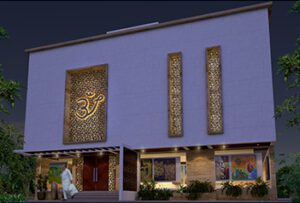

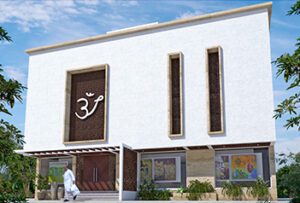

The Museum was inaugurated on Vaisakh Sud 1, Veer Samvat 2544 (16th April 2018), by The Trustees of Shree Digamber Jain Swadhyay Mandir, Songadh and Shree Kundkund-Kahan Parmarthik Trust, Mumbai. Since then, thousands of devotees have visited the museum and marveled at the beauty and detailing of each of the paintings and sculptures. More details about the museum is available on below link.
Reference: Visit Here
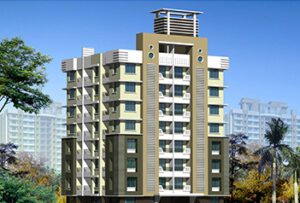

Gurupratap is a state of art facility. First allotment of flat was done on Aaso Sud 9, Veer Samvat 2539 (13th October, 2013). This building is dedicated to all the Bramhachariben’s at Songadh. These bramhachariben’s have dedicated their lives for penance (Atmasadhana) at Songadh under the virtuous aegis of Pu. Gurudevshree and Pu. Bahenshree. They are benefited with the pious daily routine of Sh. Digamber Jain Swadhyay Mandir. This routine includes Sh. Jinendradev’s Abhishek, Pooja, Bhakti; Pu. Gurudevshree’s audio lectures (3 times); Pu. Bahenshree’s audio discussions (Tatvacharcha) and religious conversations with fellow sadharmis.


Guruprabhav is a state of art facility. First allotment of flat was done on Faagan Vad 5, Veer Samvat 2542 (28th March, 2016). This building is dedicated to all the aspirant mumukshus who wish to live in Songadh. These mumukshus have aspirations to dedicate their lives for penance (Atmasadhana) at Songadh under the virtuous aegis of Pu. Gurudevshree and Pu. Bahenshree. They are benefited with the pious daily routine of Sh. Digamber Jain Swadhyay Mandir. This routine includes Sh. Jinendradev’s Abhishek, Pooja, Bhakti; Pu. Gurudevshree’s audio lectures (3 times); Pu. Bahenshree’s audio discussions (Tatvacharcha) and religious conversations with fellow sadharmis.
